Winter in Portugal brings powerful swells, fewer crowds, and some of the best waves of the year—but it also comes with colder water, strong winds, and unpredictable conditions. If you want to make the most of the winter season, you need the right mindset, preparation, and gear. Here’s your ultimate guide to surviving and thriving during winter surf sessions in Portugal.
While many surfers pack away their boards in the colder months, winter is when Portugal’s entire coastline comes to life. From the powerful beach breaks of the north to the protected coves of the Algarve, the North Atlantic sends consistent swells, lighting up waves across the country.
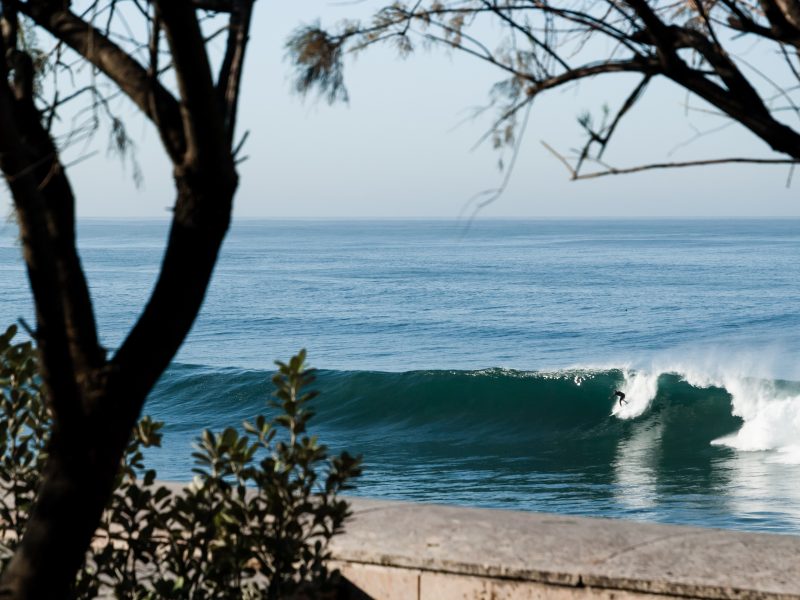
Why Winter Surfing in Portugal Is Worth It
✅ Better Waves: Stronger, more consistent swells bring world-class conditions.
✅ Fewer Crowds: Less competition for waves, giving you more opportunities to improve.
✅ Progression: Heavier, more powerful waves push your limits and force you to level up.
But with great waves come great challenges—cold water, unpredictable weather, and powerful surf. To make the most of it, you’ll need the right strategy, knowledge, and mindset. Let’s break it down.
How to Prepare for Winter Surfing 💪🌊
Winter waves are heavier, more powerful, and more demanding than summer swells. If you want to surf well (and safely), you need to be physically and mentally ready.
🏋️ Stay Fit: Train for Strength, Cardio & Explosiveness
Winter surf requires strong paddling, endurance, and quick reactions. A good training plan should focus on:
✅ Cardio: Running, swimming, or cycling to improve stamina for long sessions.
✅ Strength Training: Core, shoulders, and legs for better stability and power.
✅ Explosiveness: Plyometric exercises, like squat jumps and burpees, to help with fast pop-ups and quick adjustments.
🏊 Improve Breath Control & Apnea Training
Bigger waves mean longer hold-downs. Practicing breath control and underwater apnea training will help you stay calm when caught inside.
✅ Pool training: Static breath holds and dynamic apnea.
✅ Ocean swimming: Build confidence in open water and currents.
✅ Body Surfing: Teaches you how to move efficiently with the waves, improves breath control, and increases ocean awareness.
🌍 Check Forecasts & Be Flexible
Winter conditions change fast. Don’t just check your usual spots—explore different breaks that work best for the conditions. Wind, swell direction, and tides all matter.
🤝 Connect with the Surf Community
Winter surfing can be challenging and unpredictable, so it helps to know the locals, find a crew, and stay informed. Join surf groups, talk to experienced surfers, and always keep safety in mind.
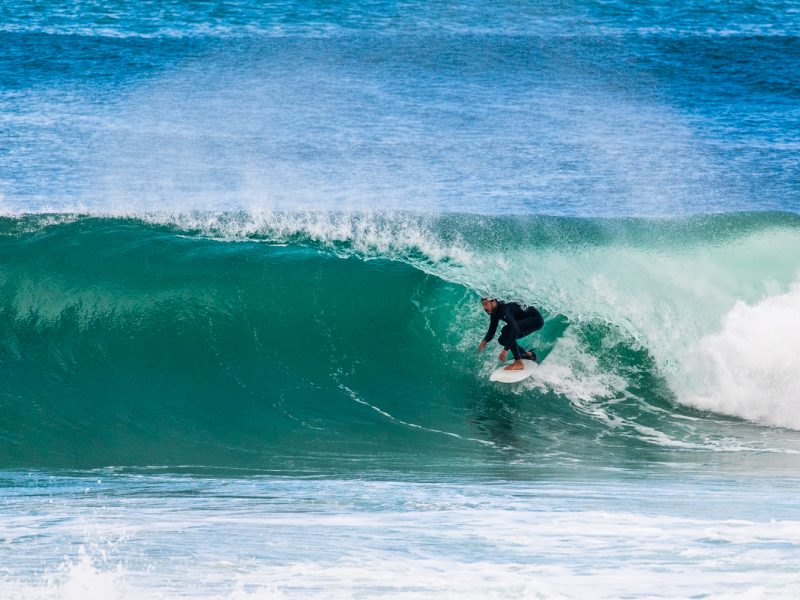
Where to Surf in Portugal During Winter
Not every spot works in the winter. The west coast is more exposed, meaning some places get too big or messy during large swells. But if you know where to look, you’ll find sheltered spots with clean waves and offshore winds.
📍 Linha de Cascais – Lisbon Area
The Lisbon/Cascais region is a great alternative when west-facing spots are maxed out. Many breaks here face south, offering clean conditions during big winter swells.
- São Pedro do Estoril: Fun rights, works well on mid-size swells.
- Carcavelos: One of Portugal’s best beach breaks, but gets crowded fast.
- Santo Amaro: A more protected option when the swell is too big elsewhere.
📍 Peniche – The All-Conditions Surf Zone
Peniche is famous for its variety of surf spots. Depending on the swell and wind, you’ll find something good almost every day.
- Supertubos: Portugal’s most famous barreling wave—but only for experienced surfers.
- Lagide: A fun, mellow left-hand reef break, perfect when the swell is solid but Supertubos is too heavy.
- Cantinho da Baía: More beginner-friendly and offers fun, clean waves.
📍 Algarve – The Winter Escape
When the north winds hit hard and the west coast is maxed out, the Algarve becomes a paradise. The southern-facing coastline provides shelter and fun, clean waves.
- Sagres: Lots of options depending on swell size, from mellow to heavy waves.
- Lagos: Offers a mix of reefs and beach breaks, perfect for different levels.
- Arrifana: One of the best winter surf spots—long, fun rights in a beautiful setting.
📍 Ericeira – World Class Waves
Ericeira gets big and heavy in the winter, but if you’re looking for sheltered and beginner-friendly spots, check out:
- Praia dos Pescadores: When it’s huge everywhere else, this is one of the only surfable options. Super safe and protected.
- Praia do Sul: Great for when the other spots are a bit too big but you still want a fun session.
- Matadouro: A super safe and fun spot for beginner surfers. Perfect for practicing in winter conditions, but watch out for strong currents and changing tides.
🎖️ Honorable Mention: Get a Cheap Flight to Morocco
If the winter in Portugal gets too intense, Morocco is just a short, cheap flight away and offers warm water, long right-hand points, and consistent winter swells. A perfect escape if you want solid waves without freezing.
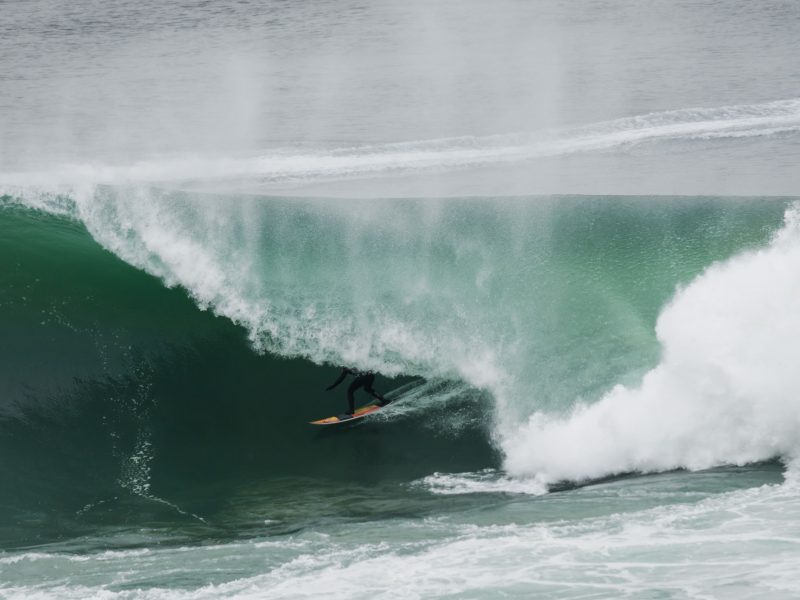
Gearing Up: The Right Equipment for Winter Surfing 🧥🌊❄️
Having the right gear is the difference between an epic winter session and a miserable one. Staying warm, comfortable, and prepared will help you surf longer and perform better in cold water.
🧥 Wetsuit: Your Second Skin
In winter, a good wetsuit is non-negotiable. Go for a 4/3mm or 5/4mm wetsuit, preferably with thermal lining to retain heat. If you feel the cold easily or plan on longer sessions, a 5/4mm with a built-in hood can make a big difference.
✅ Chest zip wetsuits provide better warmth and flexibility than back zips.
✅ Taped and sealed seams prevent cold water from flushing in.
✅ A snug fit ensures warmth—avoid wetsuits that feel too loose.
🧢 Essential Winter Surf Accessories
Winter surfing isn’t just about a good wetsuit—you need the right accessories to keep warm before, during, and after your session.
- Boots (3-5mm): Keep your feet warm and improve grip on your board.
- Gloves (Optional): If you surf in harsher northern conditions.
- Hood (Optional): Helps in strong winds or extra-cold days.
- Vaseline or Zinc: Protects your skin from windburn and cold.
- Thermal rash vest: Adds an extra layer of warmth underneath your wetsuit.
🔥 Pro Tips to Stay Warmer
- Pre-heat your wetsuit & towel: Fill a warm water bottle or a thick plastic bag with hot water and pour it into your wetsuit before putting it on. You can also use it to warm up your towel for when you get out of the water.
- Avoid getting cold before paddling out: Don’t stand around in the wind—stay in your car or covered until it’s time to hit the water.
Post-Surf Recovery: Stay Warm & Healthy 🔥❄️
Winter surf sessions drain your energy fast—cold water, heavy paddling, and long hold-downs take a toll on your body. How you recover after a session is just as important as how you prepare.
🔥 Dry Off & Warm Up Quickly
The moment you get out of the water, your body starts losing heat fast. The goal is to warm up gradually without shocking your system.
✅ Use your pre-warmed towel (see previous section) to dry off immediately.
✅ Change out of your wetsuit ASAP—cold, wet neoprene will keep pulling heat from your body.
✅ Layer up: Thick socks, a warm hoodie, and a beanie make a huge difference.
🥤 Rehydrate & Refuel
Cold water tricks your body into thinking it’s not thirsty, but you still lose fluids through exertion.
✅ Drink warm tea or water to help regulate body temperature.
✅ Eat a post-surf meal with protein and healthy fats to aid muscle recovery.
🚿 Hot Showers: Do It Right
A hot shower feels amazing after a winter session, but don’t jump straight in—this can cause dizziness and a sudden drop in blood pressure.
✅ Let your body warm up naturally for a few minutes first.
✅ Start with lukewarm water before going full hot.
🛌 Rest & Stretch
Your muscles take a beating in winter conditions—cool-down and rest will help prevent soreness and stiffness.
✅ Stretch your shoulders, back, and hips to stay loose for the next session.
✅ Listen to your body—if you’re exhausted, take a day off to recover properly.
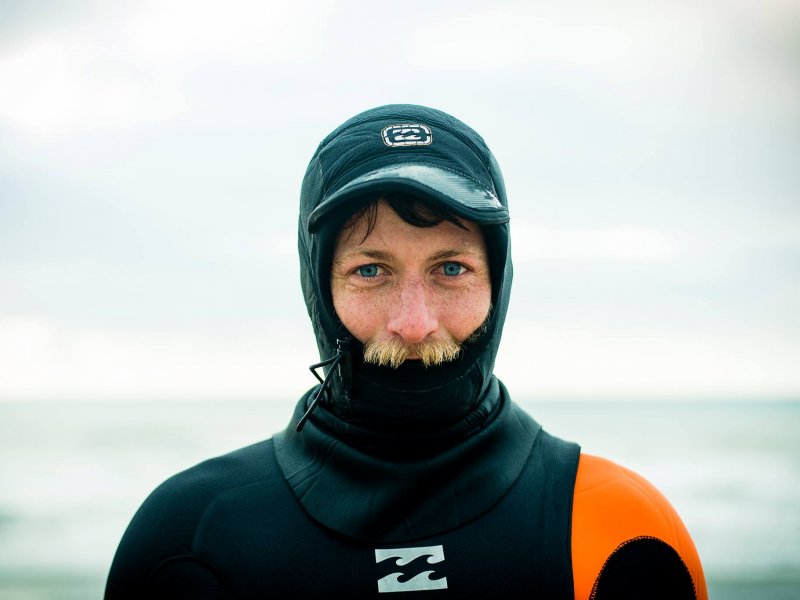
Winter Surfing Techniques & Safety Tips 🌊⚠️
Winter waves hit harder, move faster, and demand better technique and awareness. Here’s how to stay safe, surf smarter, and make the most of the season.
🏄 Smart Warm-Up for Winter Surfing
Cold muscles don’t just slow you down—they increase the risk of injury and slow reaction times. A proper warm-up should prepare your body and nervous system for powerful winter waves.
1️⃣ Activate Your Heart Rate – Get your blood flowing with jumping jacks, high knees, or fast arm circles.
2️⃣ Improve Mobility – Loosen up your hips, shoulders, and spine with arm swings, hip rotations, and spinal twists.
3️⃣ Fire Up Your Nervous System – Activate fast-twitch muscles with squat jumps or explosive push-ups.
4️⃣ Surf-Specific Movements – Simulate a pop-up a few times or do duck dive push-ups to prepare for real in-water movements.
💨 Mastering Breath Control
Cold water and heavy wipeouts can trigger panic and energy loss. Learning to control your breathing will help you stay calm and conserve energy.
✅ Before paddling into a set, take slow, deep breaths to prevent hyperventilation.
✅ If held down, count in your head—this keeps your mind focused and helps avoid panic.
✅ Wait for the turbulence to settle before swimming up—rushing to the surface wastes energy and can disorient you.
🌊 Choose the Right Spot & Conditions
Winter swells can be unpredictable and intimidating. Choosing the right spot and reading the ocean properly will keep you safe and confident.
✅ Know Your Limits – Don’t paddle into waves beyond your skill level. Progress gradually.
✅ Read the Ocean Carefully – Watch wave patterns, currents, and set timing before heading out.
✅ Observe Other Surfers – See where they’re paddling in, sitting, and how they’re handling the conditions.
✅ Find Safe Entry & Exit Points – Some spots have tricky paddle-outs, so know where the safest channels are.
✅ Check the Biggest Sets – Don’t just look at the inside waves—watch a full set to gauge the real size.
✅ Go with Someone Who Knows the Spot – Local knowledge can be the difference between a great session and a dangerous one.
✅ Adjust Your Gear to the Conditions – Bigger waves may require a step-up board with more volume for better paddling and stability.
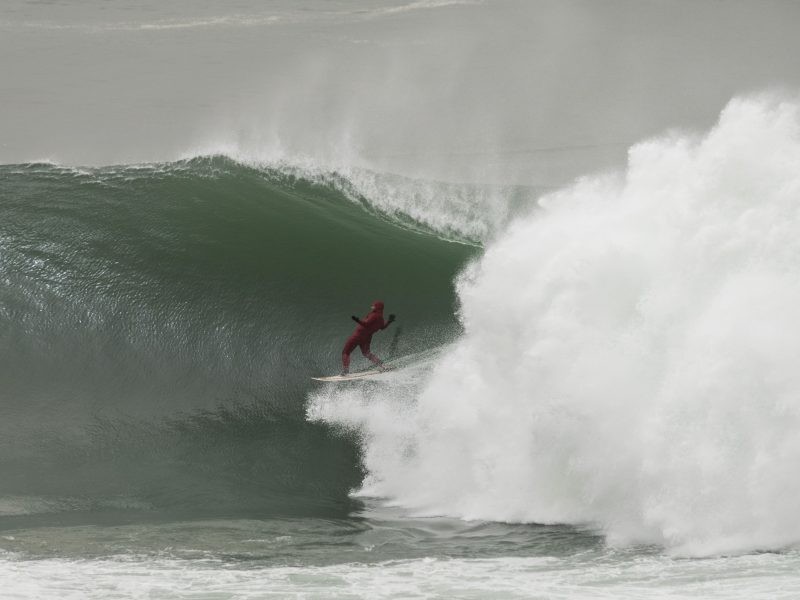
Sometimes, Just Watch & Enjoy the Show 👀🌊
Not every winter swell is meant to be surfed—and that’s okay. Some days, the waves are too big, too powerful, or just too chaotic. Instead of forcing a risky session, take a step back and enjoy the spectacle.
Portugal is home to some of the most incredible winter waves in the world, and watching them in full force can be just as inspiring as riding them. If the conditions aren’t right for you, use the opportunity to learn, observe, and witness elite surfers pushing the limits.
🏆 Nazaré – Home to the biggest waves on the planet, where tow-in surfers ride mountains of water that defy imagination.
🏆 Capítulo Perfeito (Carcavelos) – A one-day, invite-only barrel contest, where only the best tube riders battle for perfection.
🏆 WSL at Supertubos – One of the heaviest beach breaks in the world, hosting the world’s best surfers in one of the most demanding conditions.
Even if you’re not paddling out, simply being around these waves teaches you a lot—from positioning and wave selection to the sheer power of the ocean.
So, on those days when surfing isn’t an option, embrace the opportunity to learn, be inspired, and soak in the magic of Portugal’s winter waves.
Final Thoughts: Embrace the Challenge & Enjoy the Rewards 🌊❄️
Winter surfing in Portugal isn’t for the faint of heart, but that’s exactly what makes it so rewarding. The waves are bigger, the crowds are thinner, and the conditions push you to become a stronger, more skilled surfer. If you prepare properly, respect the ocean, and embrace the challenge, winter will be your greatest teacher.
Some days, you’ll score the session of your life. Other days, you’ll wipe out, learn, and grow. And on the biggest days, you might just sit back, watch, and take it all in. Either way, you’re progressing.
👉 Want to make the most of your winter sessions? Whether you need coaching, tips, or just some guidance on where to surf, reach out—we’re here to help!




